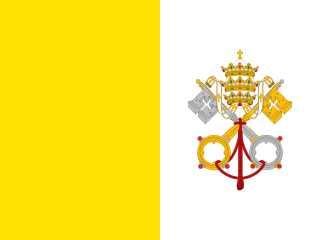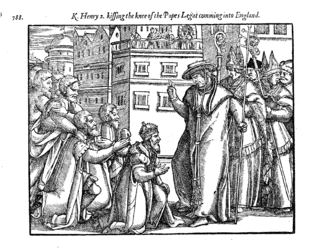
The Holy See, also called the See of Rome or Apostolic See, is the jurisdiction of the Bishop of Rome, known as the Pope, which includes the apostolic episcopal see of the Diocese of Rome with universal ecclesiastical jurisdiction of the worldwide Catholic Church, as well as a sovereign entity of international law, governing the Vatican City.

The pope, also known as the supreme pontiff or the Roman pontiff, is the bishop of Rome, head of the worldwide Catholic Church and head of state or sovereign of the Vatican City State. According to Catholics, the primacy of the bishop of Rome is largely derived from his role as the apostolic successor to Saint Peter, to whom primacy was conferred by Jesus, giving him the Keys of Heaven and the powers of "binding and loosing", naming him as the "rock" upon which the church would be built. The current pope is Francis, who was elected on 13 March 2013.

Ultramontanism is a clerical political conception within the Catholic Church that places strong emphasis on the prerogatives and powers of the Pope.

The Avignon Papacy, also known as the Babylonian Captivity, was the period from 1309 to 1376 during which seven successive popes resided in Avignon rather than in Rome. The situation arose from the conflict between the papacy and the French crown, culminating in the death of Pope Boniface VIII after his arrest and maltreatment by Philip IV of France. Following the further death of Pope Benedict XI, Philip forced a deadlocked conclave to elect the French Clement V as pope in 1305. Clement refused to move to Rome, and in 1309 he moved his court to the papal enclave at Avignon, where it remained for the next 67 years. This absence from Rome is sometimes referred to as the "Babylonian captivity of the Papacy".
Pope Lucius III, born Ubaldo Allucingoli, reigned from 1 September 1181 to his death. Born of an aristocratic family of Lucca, prior to being elected pope, he had a long career as a papal diplomat. His papacy was marked by conflicts with Holy Roman Emperor Frederick I, his exile from Rome and the initial preparations for the Third Crusade.

Pius IX was head of the Catholic Church from 1846 to 1878, the longest verifiable papal reign. After starting as a liberal, he changed course and condemned liberalism. He was notable for convoking the First Vatican Council in 1868 and for permanently losing papal control of the Papal States in 1870 to the Kingdom of Italy. He refused to leave Vatican City, declaring himself a "prisoner of the Vatican". His diplomacy mixes many failures with some successes such as Austria-Hungary, Portugal, Spain, Canada, Tuscany, Ecuador, Venezuela, Honduras, El Salvador, and Haiti.

The Papal States, officially the State of the Church, were a series of territories in the Italian Peninsula under the direct sovereign rule of the pope from the 8th century until 1870. They were among the major states of Italy from roughly the 8th century until the Kingdom of Piedmont-Sardinia unified the Italian Peninsula by conquest in a campaign virtually concluded in 1861 and definitively in 1870.

John Murphy Farley was an Irish-American cardinal of the Roman Catholic Church. He served as Archbishop of New York from 1902 until his death in 1918, and was created a cardinal in 1911.

The Western Schism, also called Papal Schism, The Vatican Standoff, Great Occidental Schism and Schism of 1378, was a split within the Catholic Church lasting from 1378 to 1417 in which bishops residing in Rome and Avignon both claimed to be the true pope, joined by a third line of Pisan popes in 1409. The schism was driven by personalities and political allegiances, with the Avignon papacy being closely associated with the French monarchy. These rival claims to the papal throne damaged the prestige of the office.

A papal legate or apostolic legate is a personal representative of the pope to foreign nations, or to some part of the Catholic Church. He is empowered on matters of Catholic faith and for the settlement of ecclesiastical matters.

The history of the papacy, the office held by the pope as head of the Catholic Church, according to Catholic doctrine, spans from the time of Peter to the present day. However the first bishop of Rome to be contemporaneously referred to as Pope is Damasus I (366–84). Moreover, many of the bishops of Rome in the first three centuries of the Christian era are obscure figures. Most of Peter's successors in the first three centuries following his life suffered martyrdom along with members of their flock in periods of persecution, and do not seem to have recognized any supreme hierarchy to be passed on within the church.
Ecclesiastical letters are publications or announcements of the organs of Roman Catholic ecclesiastical authority, e.g. the synods, but more particularly of pope and bishops, addressed to the faithful in the form of letters.

The Renaissance Papacy was a period of papal history between the Western Schism and the Protestant Reformation. From the election of Pope Martin V of the Council of Constance in 1417 to the Reformation in the 16th century, Western Christianity was largely free from schism as well as significant disputed papal claimants. There were many important divisions over the direction of the religion, but these were resolved through the then-settled procedures of the papal conclave.

Somogysimonyi is a village in Somogy County, Hungary. It incorporates the earlier separated villages of Gardos-puszta, Irma-puszta and Angyalvár-telep.
The papal deposing power was the most powerful tool of the political authority claimed by and on behalf of the Roman Pontiff, in medieval and early modern thought, amounting to the assertion of the Pope's power to declare a Christian monarch heretical and powerless to rule.

Papal infallibility is a dogma of the Roman Catholic Church which states that, in virtue of the promise of Jesus to Peter, the pope when appealing to his highest authority is preserved from the possibility of error on doctrine "initially given to the apostolic Church and handed down in Scripture and tradition". This doctrine was defined dogmatically at the First Vatican Council of 1869–1870 in the document Pastor aeternus, but had been defended before that, existing already in medieval theology and being the majority opinion at the time of the Counter-Reformation.

With a long history as a vantage point for anti-popes forces threatening Rome, Viterbo became a papal city in 1243. During the later thirteenth century, the ancient Italian city of Viterbo was the site of five papal elections and the residence of seven popes and their Curias, and it remains the location of four papal tombs. These popes resided in the Palazzo dei Papi di Viterbo alongside the Viterbo Cathedral intermittently for two decades, from 1257 to 1281; as a result, the papal palace in Viterbo, with that in Orvieto, are the most extensive thirteenth-century papal palaces to have survived.

The orders, decorations, and medals of the Holy See include titles, chivalric orders, distinctions and medals honoured by the Holy See, with the Pope as the fount of honour, for deeds and merits of their recipients to the benefit of the Holy See, the Catholic Church, or their respective communities, societies, nations and the world at large.

Foreign relations between the Holy See and Switzerland are among the oldest bilateral diplomatic relations, beginning with the admission of a papal nuncio to Lucerne in 1586. About 40% of the Swiss population are Catholics, and young Swiss men have served for centuries in the Pontifical Swiss Guard.

In the Catholic Church, a basilica is a large and important church building designated as a basilica by the Pope and thereby distinguished for ceremonial purposes from other churches. It does not need to be a basilica in the architectural sense. Basilicas are either major basilicas – of which there are four, all in the Diocese of Rome – or minor basilicas, of which there were 1,810 worldwide as of 2019.

















